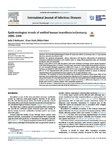Epidemiological trends of notified human brucellosis in Germany, 2006–2018
Enkelmann, Julia
Stark, Klaus
Faber, Mirko
Objective
We describe epidemiological trends of human brucellosis in Germany over a 13 year period based on national surveillance data.
Methods
We analyzed demographic, clinical, laboratory and exposure information of symptomatic laboratory-confirmed brucellosis cases notified 2006–18. Using official population data, we calculated incidences and risk ratios (RR).
Results
From 2006 to 2018, 408 brucellosis cases were notified in Germany (mean annual incidence: 0.38/1,000,000 population), of which 75% were travel-associated. Yearly notifications peaked in 2014 (n = 47) and remained elevated compared to 2006–2013 (mean: n = 25). Asylum seekers (AS) arriving in Germany accounted for 9/44 (2015) and 15/36 (2016) cases, respectively. RR AS/non-AS 2015–2016: 28, 95% CI: 17–45. Unpasteurized milk products were most frequently notified as source of infection. Imported food and occupational exposure played a role in autochthonous cases.
Conclusions
The incidence of human brucellosis has markedly increased in recent years. Most of the observed rise in notifications can be explained by infections in AS. Exposure still predominantly occurs abroad. Risk factors for autochthonous infections need to be investigated further, though imported dairy products seem to play a role. Physicians should consider brucellosis as differential diagnosis in AS and people with travel to endemic regions with compatible symptoms.
Files in this item

